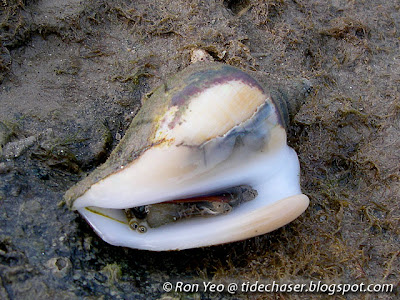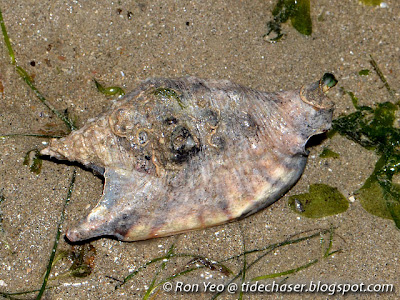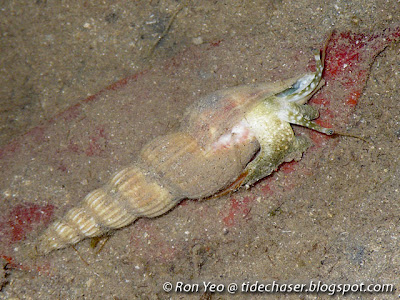The strombids, or conches, are a diverse group of snails with thick shells, especially the outer lips. The operculum is thin and long with serrated edges, and is used like a "walking stick" to anchor the animal as it moves by dragging the shell along, sometimes in leaps. The aperture is usually elongated, with a well-marked siphonal canal. They have a pair of eyes on long stalks, allowing them to peep out of their shells to check for threats before they move. Many species are collected by human for food, and the pretty shells collected for making decorative items. The shells vary widely from species to species - some may come with long spines while others may not, while some may have a much longer spire. Strombids are mostly herbivorous, feeding on algae, and occasionally detritivorous (i.e. feeding on tiny decaying matter). Their shells are usually very well camouflaged, covered with algae, silt and even corals sometimes.
I have seen several species of conches on our shores (thanks to Siong Kiat who gave tips on how to identify them!). You may want to take a look at my diagram on the parts of a snail's shell if you are not familiar with the names of the parts, so as to better understand the terms used below.

The Spider Conch (Lambis lambis) is often seen on our shores, on reef flats. The shell is large, thick and heavy, with a moderately high, pointed spire, and large hollow marginal spines on the flaring outer lip. The top side of the shell is often covered with encrusting organisms, such as seaweed or corals.

The aperture is clean and and white. The margins may be purplish, and the columella may be mottled with brown or purplish patterns. The body is greenish or brownish with whitish spots. The operculum is long and thin, like other strombids. They feed on fine red algae, and grow to about 20cm long.

Juvenile Spider Conches lack the long marginal spines on the outer lip.

The Gong Gong (Laevistrombus turturella) is possibly the commonest intertidal conch species in Singapore. It can be found on muddy to sandy substrates, but can be hard to spot as the top side is usually coated with sediment and hence very well camouflaged. When cleaned, the shell is light brown in colour.

The aperture is white, with the outer lip roughly wing-shaped and thickened. It is commonly collected for food, and can grow to about 10cm long, but the ones in Singapore is mostly about 6cm.

The egg capsules appear like a compact mess of strings.

The Black-lipped Conch (Canarium urceus) is rather commonly seen on our shores, and can be easily differentiated from other similar-sized conches by the black lips of the aperture. Specimens from deeper waters, however, may not have the black lips.

It is usually found on sandy or muddy-sandy substrates. The shell appear slimmer compared to the similar-looking Gong Gong. It grows to about 6cm long.

The Marginate Conch (Margistrombus marginatus) is occasionally seen on sandy substrates, and can be mistaken for the Gong Gong unless you take a closer look. It lacks the wing-shaped outer lip of the latter, and has a more sharply pointed, turret-like spire.

The pattern on a clean shell is unmistakable though - with elaborated spiral bands and intricate patterns.

The Plough Conch (Euprotomus aratrum) is seldom seen on our shores. It is characterised by an acute protruding extension with a rounded tip on the flared outer lip posteriorly.

The aperture is pinkish or orange inside, with the margin coloured black or dark grey. It grows to about 9cm long.

I have only seen a juvenile Vittate Conch (Doxander vittatus) once in Singapore, on a sandy shore. In biology, the word "vittate" means "striped lengthwise", refering to the fine ridges running down from the apex to the siphonal notch.

It has a long spire - in adults, it is about half the length of the shell (if not shorter), but in juveniles like the above, it can be longer than the body whorl. Adult snails will also have thickened outer lips. The colour of the shell is light brown, while the aperture is white. It can grow to about 10cm.
References
I have seen several species of conches on our shores (thanks to Siong Kiat who gave tips on how to identify them!). You may want to take a look at my diagram on the parts of a snail's shell if you are not familiar with the names of the parts, so as to better understand the terms used below.

The Spider Conch (Lambis lambis) is often seen on our shores, on reef flats. The shell is large, thick and heavy, with a moderately high, pointed spire, and large hollow marginal spines on the flaring outer lip. The top side of the shell is often covered with encrusting organisms, such as seaweed or corals.

The aperture is clean and and white. The margins may be purplish, and the columella may be mottled with brown or purplish patterns. The body is greenish or brownish with whitish spots. The operculum is long and thin, like other strombids. They feed on fine red algae, and grow to about 20cm long.

Juvenile Spider Conches lack the long marginal spines on the outer lip.

The Gong Gong (Laevistrombus turturella) is possibly the commonest intertidal conch species in Singapore. It can be found on muddy to sandy substrates, but can be hard to spot as the top side is usually coated with sediment and hence very well camouflaged. When cleaned, the shell is light brown in colour.

The aperture is white, with the outer lip roughly wing-shaped and thickened. It is commonly collected for food, and can grow to about 10cm long, but the ones in Singapore is mostly about 6cm.

The egg capsules appear like a compact mess of strings.

The Black-lipped Conch (Canarium urceus) is rather commonly seen on our shores, and can be easily differentiated from other similar-sized conches by the black lips of the aperture. Specimens from deeper waters, however, may not have the black lips.

It is usually found on sandy or muddy-sandy substrates. The shell appear slimmer compared to the similar-looking Gong Gong. It grows to about 6cm long.

The Marginate Conch (Margistrombus marginatus) is occasionally seen on sandy substrates, and can be mistaken for the Gong Gong unless you take a closer look. It lacks the wing-shaped outer lip of the latter, and has a more sharply pointed, turret-like spire.

The pattern on a clean shell is unmistakable though - with elaborated spiral bands and intricate patterns.

The Plough Conch (Euprotomus aratrum) is seldom seen on our shores. It is characterised by an acute protruding extension with a rounded tip on the flared outer lip posteriorly.

The aperture is pinkish or orange inside, with the margin coloured black or dark grey. It grows to about 9cm long.

I have only seen a juvenile Vittate Conch (Doxander vittatus) once in Singapore, on a sandy shore. In biology, the word "vittate" means "striped lengthwise", refering to the fine ridges running down from the apex to the siphonal notch.

It has a long spire - in adults, it is about half the length of the shell (if not shorter), but in juveniles like the above, it can be longer than the body whorl. Adult snails will also have thickened outer lips. The colour of the shell is light brown, while the aperture is white. It can grow to about 10cm.
References
- Abbott, R. T., 1991. Seashells of Southeast Asia. Graham Brash, Singapore. 145 pp.
- Carpenter, K. E. and V. H. Niem (eds). 1998-2001. FAO species identification guide for fishery purposes. The living marine resources of the Western Central Pacific. Volumes 1 to 6. FAO, Rome. pp. 1-4218.
- Gladys Archerd Shell Collection at Washington State University Tri-Cities Natural History Museum. 2008. Retrieved September 26, 2012, from http://shells.tricity.wsu.edu/ArcherdShellCollection/ShellCollection.html.
- Oliver, A. P. H. 2012. Philip's guide to seashells of the world. Philip's, London. 320 pp.
- Tan, K. S. & L. M. Chou, 2000. A guide to common seashells of Singapore. Singapore Science Centre, Singapore. 168 pp.
- Tan, S. K. & H. P. M. Woo, 2010. A preliminary checklist of the molluscs of Singapore. Raffles Museum of Biodiversity Research, National University of Singapore, Singapore. 78 pp. Uploaded 02 June 2010.
- Tan, S. K. & R. K. H. Yeo, 2010. The intertidal molluscs of Pulau Semakau: preliminary results of “Project Semakau”. Nature in Singapore, 3: 287–296.
- World Register of Marine Species. 2012. Retrieved Oct 3, 2012, from http://www.marinespecies.org.

No comments:
Post a Comment